Abstract
Among neutropenic patients with hematologic malignancies, candidemia has been shown to arise typically from autoinfection after colonization. In patients without neutropenia, we examined the similarities of strains colonizing or infecting various body sites and those subsequently causing Candida bloodstream infections. Strain similarity was examined by karyotyping and restriction endonuclease analysis of genomic DNA (REAG) by using two restriction enzymes (SfiI and BssHII). The banding patterns of 42 isolates from 19 patients were independently evaluated in a blinded fashion by three observers. The interobserver reliability measured with a generalized kappa statistic was 0.59 for karyotyping, 0.84 for REAG with SfiI, and 0.88 for REAG with BssHII (P < 0.001 for each). REAG classified the initial colonizing or infecting isolate and subsequent blood isolates as identical in 16 patients (84%). The mean duration of colonization or infection prior to a positive blood culture was 5 and 23 days in patients infected with related and unrelated isolates, respectively (P = 0.14; 95% confidence interval = -14.5 to 50.5). Karyotyping results matched the REAG results for isolates from 14 of the 19 patients (74%). In patients infected with identical isolates, the initial isolate was most frequently recovered from the urine (n = 5) or vascular catheter tips (n = 4). In the five subjects with organisms showing disparate results between the methods, karyotyping revealed different banding patterns, whereas REAG suggested that the isolates were identical. Candida colonization or infection with an identical strain frequently precedes bloodstream infection in nonneutropenic patients. Future studies should evaluate whether patients at high risk for candidemia and who have vascular catheter or urine samples that are positive for a Candida on culture should be treated empirically.
Full text
PDF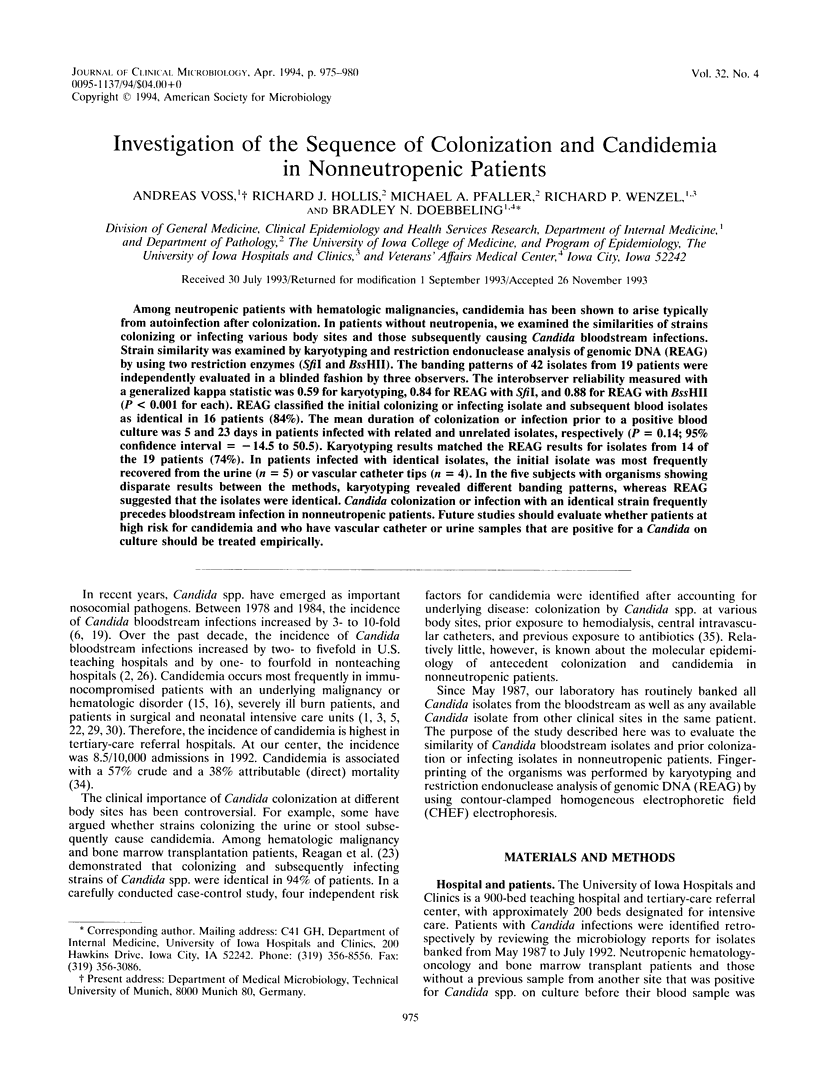
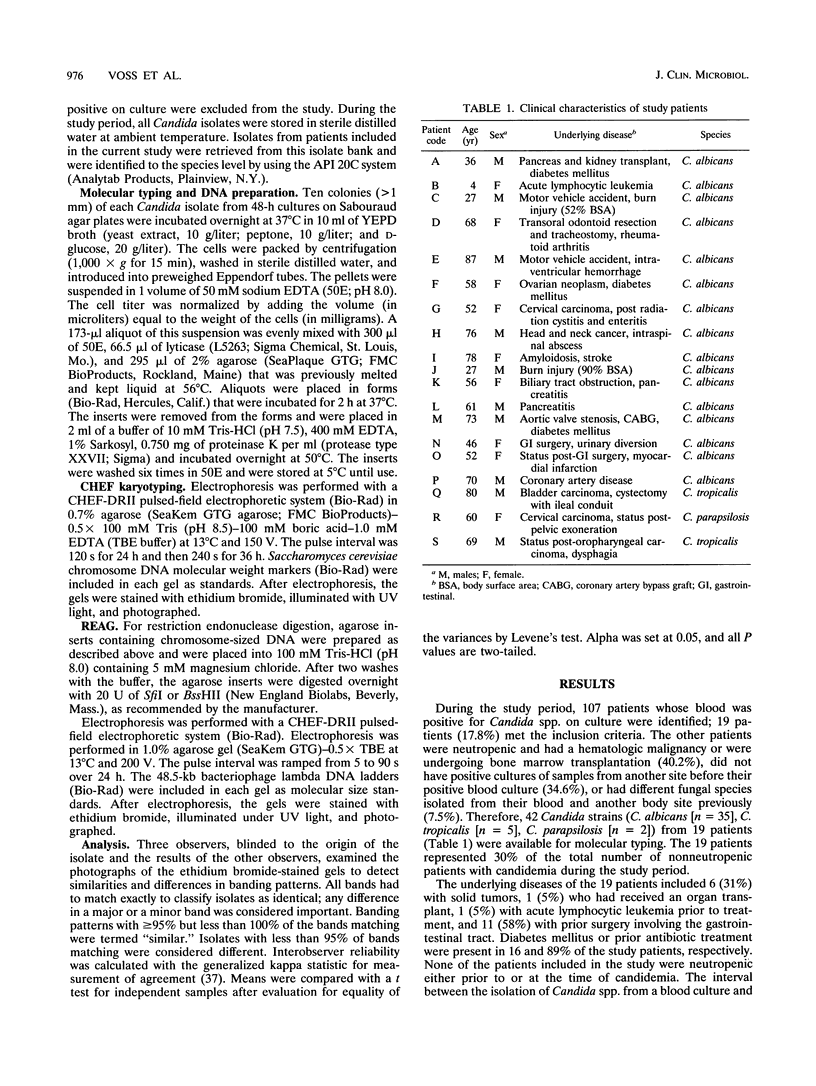
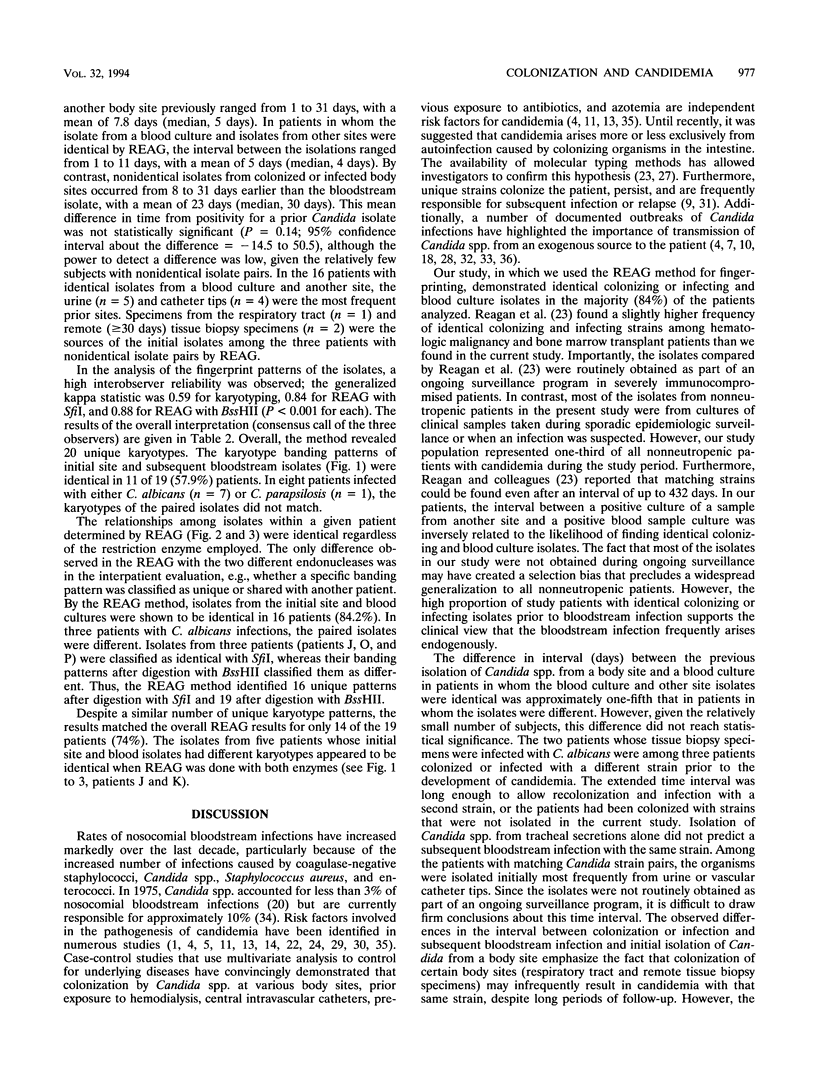
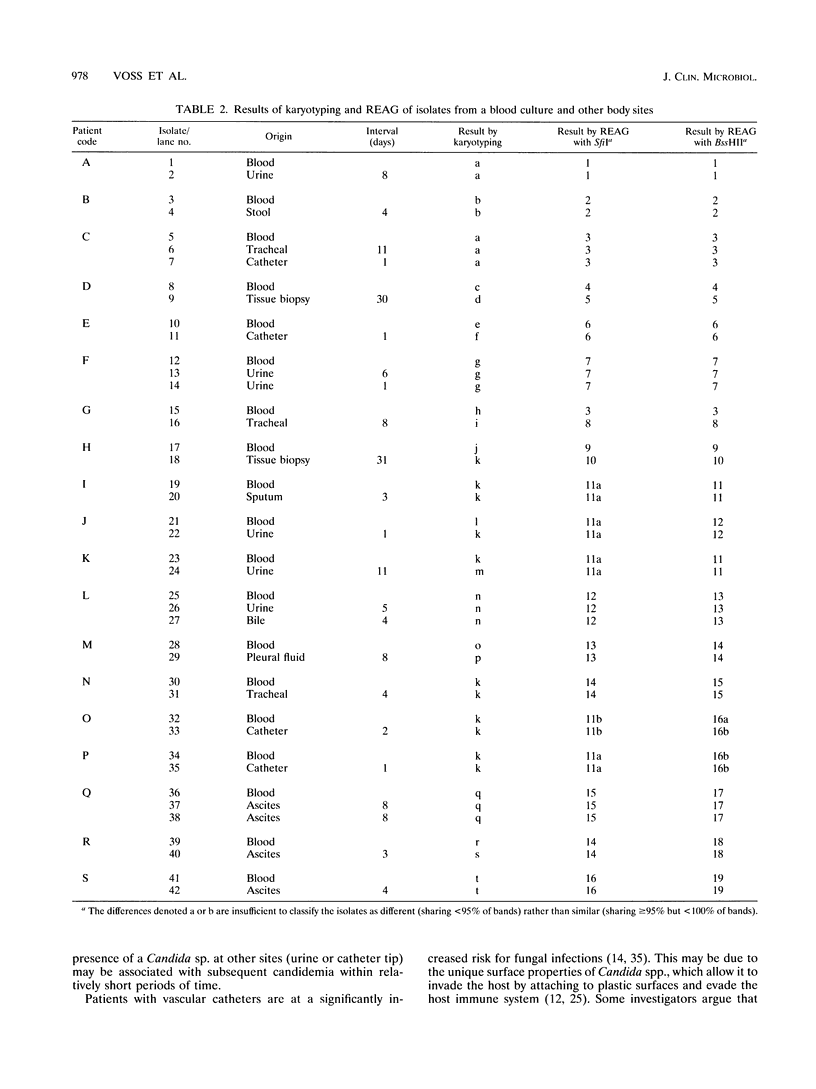
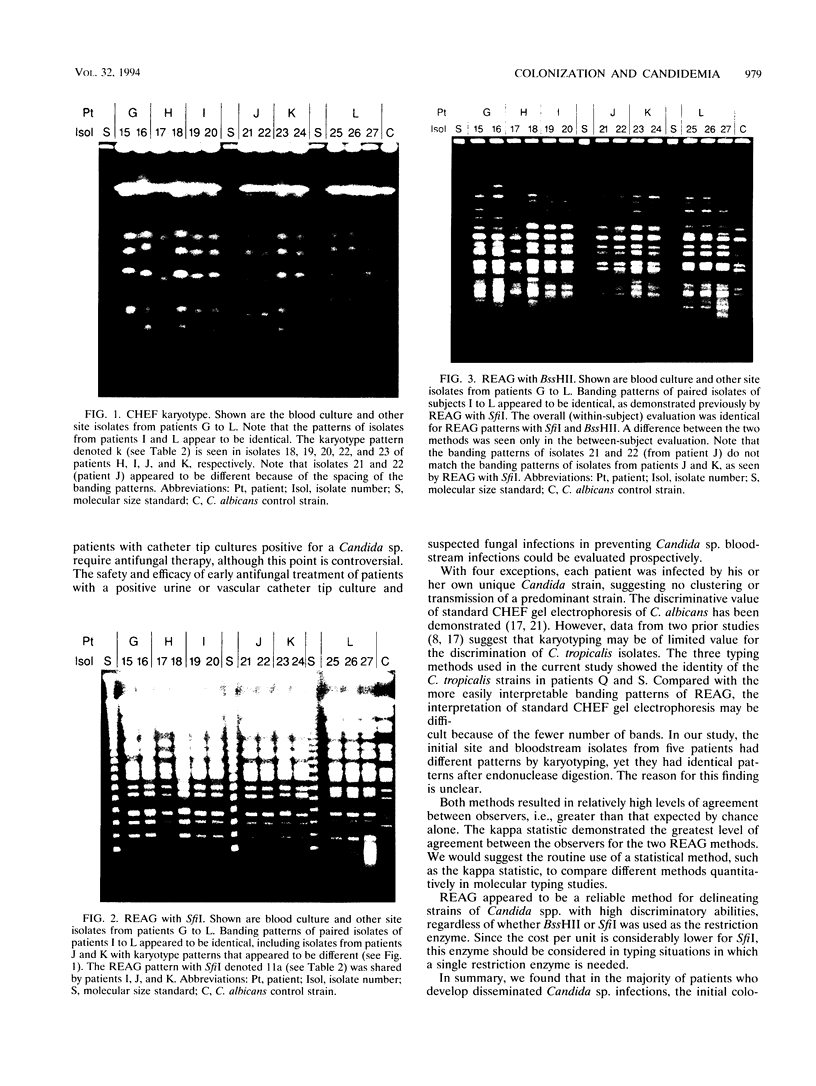
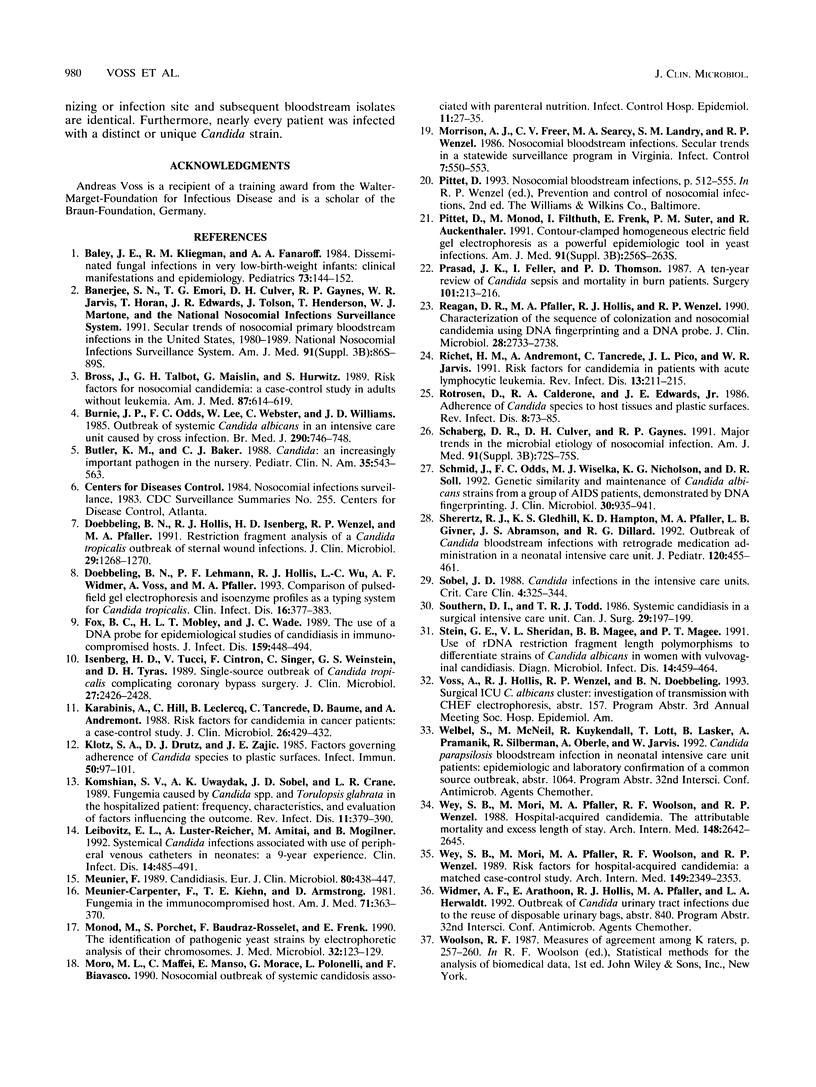
Images in this article
Selected References
These references are in PubMed. This may not be the complete list of references from this article.
- Baley J. E., Kliegman R. M., Fanaroff A. A. Disseminated fungal infections in very low-birth-weight infants: clinical manifestations and epidemiology. Pediatrics. 1984 Feb;73(2):144–152. [PubMed] [Google Scholar]
- Banerjee S. N., Emori T. G., Culver D. H., Gaynes R. P., Jarvis W. R., Horan T., Edwards J. R., Tolson J., Henderson T., Martone W. J. Secular trends in nosocomial primary bloodstream infections in the United States, 1980-1989. National Nosocomial Infections Surveillance System. Am J Med. 1991 Sep 16;91(3B):86S–89S. doi: 10.1016/0002-9343(91)90349-3. [DOI] [PubMed] [Google Scholar]
- Bross J., Talbot G. H., Maislin G., Hurwitz S., Strom B. L. Risk factors for nosocomial candidemia: a case-control study in adults without leukemia. Am J Med. 1989 Dec;87(6):614–620. doi: 10.1016/s0002-9343(89)80392-4. [DOI] [PubMed] [Google Scholar]
- Burnie J. P., Odds F. C., Lee W., Webster C., Williams J. D. Outbreak of systemic Candida albicans in intensive care unit caused by cross infection. Br Med J (Clin Res Ed) 1985 Mar 9;290(6470):746–748. doi: 10.1136/bmj.290.6470.746. [DOI] [PMC free article] [PubMed] [Google Scholar]
- Butler K. M., Baker C. J. Candida: an increasingly important pathogen in the nursery. Pediatr Clin North Am. 1988 Jun;35(3):543–563. doi: 10.1016/s0031-3955(16)36471-9. [DOI] [PubMed] [Google Scholar]
- Doebbeling B. N., Hollis R. J., Isenberg H. D., Wenzel R. P., Pfaller M. A. Restriction fragment analysis of a Candida tropicalis outbreak of sternal wound infections. J Clin Microbiol. 1991 Jun;29(6):1268–1270. doi: 10.1128/jcm.29.6.1268-1270.1991. [DOI] [PMC free article] [PubMed] [Google Scholar]
- Doebbeling B. N., Lehmann P. F., Hollis R. J., Wu L. C., Widmer A. F., Voss A., Pfaller M. A. Comparison of pulsed-field gel electrophoresis with isoenzyme profiles as a typing system for Candida tropicalis. Clin Infect Dis. 1993 Mar;16(3):377–383. doi: 10.1093/clind/16.3.377. [DOI] [PubMed] [Google Scholar]
- Fox B. C., Mobley H. L., Wade J. C. The use of a DNA probe for epidemiological studies of candidiasis in immunocompromised hosts. J Infect Dis. 1989 Mar;159(3):488–494. doi: 10.1093/infdis/159.3.488. [DOI] [PubMed] [Google Scholar]
- Isenberg H. D., Tucci V., Cintron F., Singer C., Weinstein G. S., Tyras D. H. Single-source outbreak of Candida tropicalis complicating coronary bypass surgery. J Clin Microbiol. 1989 Nov;27(11):2426–2428. doi: 10.1128/jcm.27.11.2426-2428.1989. [DOI] [PMC free article] [PubMed] [Google Scholar]
- Karabinis A., Hill C., Leclercq B., Tancrède C., Baume D., Andremont A. Risk factors for candidemia in cancer patients: a case-control study. J Clin Microbiol. 1988 Mar;26(3):429–432. doi: 10.1128/jcm.26.3.429-432.1988. [DOI] [PMC free article] [PubMed] [Google Scholar]
- Klotz S. A., Drutz D. J., Zajic J. E. Factors governing adherence of Candida species to plastic surfaces. Infect Immun. 1985 Oct;50(1):97–101. doi: 10.1128/iai.50.1.97-101.1985. [DOI] [PMC free article] [PubMed] [Google Scholar]
- Komshian S. V., Uwaydah A. K., Sobel J. D., Crane L. R. Fungemia caused by Candida species and Torulopsis glabrata in the hospitalized patient: frequency, characteristics, and evaluation of factors influencing outcome. Rev Infect Dis. 1989 May-Jun;11(3):379–390. doi: 10.1093/clinids/11.3.379. [DOI] [PubMed] [Google Scholar]
- Leibovitz E., Iuster-Reicher A., Amitai M., Mogilner B. Systemic candidal infections associated with use of peripheral venous catheters in neonates: a 9-year experience. Clin Infect Dis. 1992 Feb;14(2):485–491. doi: 10.1093/clinids/14.2.485. [DOI] [PubMed] [Google Scholar]
- Meunier-Carpentier F., Kiehn T. E., Armstrong D. Fungemia in the immunocompromised host. Changing patterns, antigenemia, high mortality. Am J Med. 1981 Sep;71(3):363–370. doi: 10.1016/0002-9343(81)90162-5. [DOI] [PubMed] [Google Scholar]
- Meunier F. Candidiasis. Eur J Clin Microbiol Infect Dis. 1989 May;8(5):438–447. doi: 10.1007/BF01964058. [DOI] [PubMed] [Google Scholar]
- Monod M., Porchet S., Baudraz-Rosselet F., Frenk E. The identification of pathogenic yeast strains by electrophoretic analysis of their chromosomes. J Med Microbiol. 1990 Jun;32(2):123–129. doi: 10.1099/00222615-32-2-123. [DOI] [PubMed] [Google Scholar]
- Moro M. L., Maffei C., Manso E., Morace G., Polonelli L., Biavasco F. Nosocomial outbreak of systemic candidosis associated with parenteral nutrition. Infect Control Hosp Epidemiol. 1990 Jan;11(1):27–35. doi: 10.1086/646075. [DOI] [PubMed] [Google Scholar]
- Morrison A. J., Jr, Freer C. V., Searcy M. A., Landry S. M., Wenzel R. P. Nosocomial bloodstream infections: secular trends in a statewide surveillance program in Virginia. Infect Control. 1986 Nov;7(11):550–553. doi: 10.1017/s0195941700065309. [DOI] [PubMed] [Google Scholar]
- Pittet D., Monod M., Filthuth I., Frenk E., Suter P. M., Auckenthaler R. Contour-clamped homogeneous electric field gel electrophoresis as a powerful epidemiologic tool in yeast infections. Am J Med. 1991 Sep 16;91(3B):256S–263S. doi: 10.1016/0002-9343(91)90378-b. [DOI] [PubMed] [Google Scholar]
- Prasad J. K., Feller I., Thomson P. D. A ten-year review of Candida sepsis and mortality in burn patients. Surgery. 1987 Feb;101(2):213–216. [PubMed] [Google Scholar]
- Reagan D. R., Pfaller M. A., Hollis R. J., Wenzel R. P. Characterization of the sequence of colonization and nosocomial candidemia using DNA fingerprinting and a DNA probe. J Clin Microbiol. 1990 Dec;28(12):2733–2738. doi: 10.1128/jcm.28.12.2733-2738.1990. [DOI] [PMC free article] [PubMed] [Google Scholar]
- Richet H. M., Andremont A., Tancrede C., Pico J. L., Jarvis W. R. Risk factors for candidemia in patients with acute lymphocytic leukemia. Rev Infect Dis. 1991 Mar-Apr;13(2):211–215. doi: 10.1093/clinids/13.2.211. [DOI] [PubMed] [Google Scholar]
- Rotrosen D., Calderone R. A., Edwards J. E., Jr Adherence of Candida species to host tissues and plastic surfaces. Rev Infect Dis. 1986 Jan-Feb;8(1):73–85. doi: 10.1093/clinids/8.1.73. [DOI] [PubMed] [Google Scholar]
- Schaberg D. R., Culver D. H., Gaynes R. P. Major trends in the microbial etiology of nosocomial infection. Am J Med. 1991 Sep 16;91(3B):72S–75S. doi: 10.1016/0002-9343(91)90346-y. [DOI] [PubMed] [Google Scholar]
- Schmid J., Odds F. C., Wiselka M. J., Nicholson K. G., Soll D. R. Genetic similarity and maintenance of Candida albicans strains from a group of AIDS patients, demonstrated by DNA fingerprinting. J Clin Microbiol. 1992 Apr;30(4):935–941. doi: 10.1128/jcm.30.4.935-941.1992. [DOI] [PMC free article] [PubMed] [Google Scholar]
- Sherertz R. J., Gledhill K. S., Hampton K. D., Pfaller M. A., Givner L. B., Abramson J. S., Dillard R. G. Outbreak of Candida bloodstream infections associated with retrograde medication administration in a neonatal intensive care unit. J Pediatr. 1992 Mar;120(3):455–461. doi: 10.1016/s0022-3476(05)80920-5. [DOI] [PubMed] [Google Scholar]
- Sobel J. D. Candida infections in the intensive care unit. Crit Care Clin. 1988 Apr;4(2):325–344. [PubMed] [Google Scholar]
- Soutter D. I., Todd T. R. Systemic candidiasis in a surgical intensive care unit. Can J Surg. 1986 May;29(3):197–199. [PubMed] [Google Scholar]
- Stein G. E., Sheridan V. L., Magee B. B., Magee P. T. Use of rDNA restriction fragment length polymorphisms to differentiate strains of Candida albicans in women with vulvovaginal candidiasis. Diagn Microbiol Infect Dis. 1991 Nov-Dec;14(6):459–464. doi: 10.1016/0732-8893(91)90001-v. [DOI] [PubMed] [Google Scholar]
- Wey S. B., Mori M., Pfaller M. A., Woolson R. F., Wenzel R. P. Hospital-acquired candidemia. The attributable mortality and excess length of stay. Arch Intern Med. 1988 Dec;148(12):2642–2645. doi: 10.1001/archinte.148.12.2642. [DOI] [PubMed] [Google Scholar]
- Wey S. B., Mori M., Pfaller M. A., Woolson R. F., Wenzel R. P. Risk factors for hospital-acquired candidemia. A matched case-control study. Arch Intern Med. 1989 Oct;149(10):2349–2353. [PubMed] [Google Scholar]





